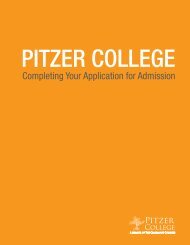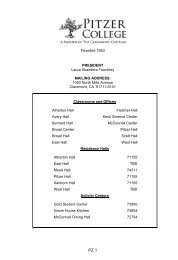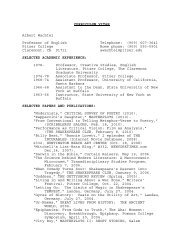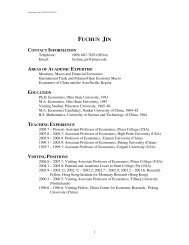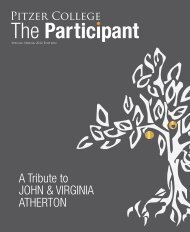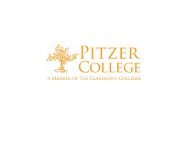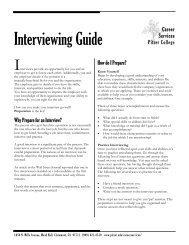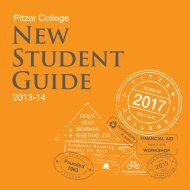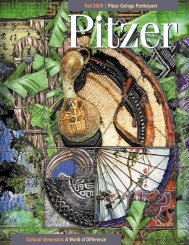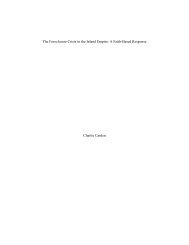Create successful ePaper yourself
Turn your PDF publications into a flip-book with our unique Google optimized e-Paper software.
292 THEATRE AND DANCE<br />
THEATRE AND DANCE<br />
52C. Theatre Production Practicum. Participation in the production aspects (scenery,<br />
properties, costumes, lighting, sound, and management) of Seaver Theatre productions.<br />
One-quarter cumulative credit. May be repeated for credit. Fall/Spring, S. Linnell/J. Taylor.<br />
52H. Theatre Production Practicum and Pedagogy. Participation in the production<br />
aspects (scenery, properties, costumes, lighting, sound or management) of Seaver Theatre<br />
productions. Paper writing required. Half-credit. Fall/Spring, S. Linnell/J. Taylor.<br />
53C. Alexander Technique. The Alexander Technique is a pragmatic method for<br />
exploring the basis of human movement, understanding how we interfere with our own<br />
coordination, and how we can change unconscious physical habits. Journals and outside<br />
practice periods are a part of the course. One-quarter cumulative credit. Fall/Spring, S. Robbins.<br />
53H. Alexander Technique and Pedagogy. Same course as 53C with additional<br />
assignments. Half-credit. Fall/Spring, S. Robbins.<br />
54C. Texts in Performance. An exploration of dramatic text through the medium of<br />
performance involving script analysis and rehearsal of texts. Culminates in the public<br />
performance of rehearsed readings and/or low budget productions of selected plays. The<br />
emphasis is on the texts themselves without the trappings of production: scenery,<br />
lighting,, costumes, etc. No acting experience is necessary. One-quarter cumulative credit.<br />
Next offered 20<strong>08</strong>-09]<br />
54H. Texts in Performance and Analysis. Same course as 54C with additional<br />
assignments. Half-credit. Staff. Next offered 20<strong>08</strong>-09.<br />
80. Scene Design. An introduction to set design for theatre and related fields of film and<br />
television. The course explores and develops the necessary conceptual, graphic, and<br />
three-dimensional skills involved in the set design process. Play going, project work and<br />
exposure to computer graphics serve to significantly broaden the course experience.<br />
Laboratory required. Spring, J. Taylor.<br />
81. Costume Design. An introductory course for the basic design principles of costume<br />
for both the actor and dancer. Line, shape, color, texture and value provide the basis for<br />
developing both period and contemporary costumes. The course uses analytical and<br />
technical drawing skills to develop costume designs. Students will have the opportunity<br />
to see and critique professional and theatre and dance department productions.<br />
Production laboratory required. Spring, S. Linnell.<br />
82. Lighting Design. An introduction to lighting design for theatre and the related fields<br />
of film and television. Once mastery of lighting equipment is achieved, the course<br />
explores and develops the necessary conceptual and graphic skills involved in the lighting<br />
design process. Play going, project work and exposure to computer graphics serve to<br />
significantly broaden the course experience. Production laboratory required. Fall, J.P. Taylor.<br />
83. Computer Graphics for the Theatre. This course is an exploration of the fast growing<br />
application of computer technology to theatrical production. The course will examine the<br />
wide variety of ways that theatre designers and technicians use computer graphics to<br />
make their work more effective and/or aesthetically pleasing. Working in a computer<br />
laboratory setting, students will use a number of software programs in creating costume<br />
design fields. The course may have a practicum component in conjunction with Pomona<br />
<strong>College</strong> production. Full credit. Alternate years. [next offered 20<strong>08</strong>-09]<br />
100A. Acting Studio: Acting for the Classical Theatre. Intensive work on rehearsal and<br />
studio performance of selected scenes from dramatic literature. Primary focus on<br />
representational drama. Continued work on vocal, physical and imaginative skills.<br />
Prerequisite: Thea 1 or 3 and 12. Staff. [next offered 20<strong>08</strong>-09]<br />
100B. Acting Studio: Acting for the Classical Theatre. Continuation of the scene study<br />
approach with emphasis on presentational plays from major theatrical periods, including<br />
the Greeks, Shakespeare, and Moliere. Prerequisites: 1, 4 or 5, and 12. Spring, A. Blumenfeld.<br />
293<br />
100C. Acting Studio: The Mask in Theatre. Involves equal part theatrical and practical<br />
work. Read Greek plays. Commedia dell arte and modern plays conceived for masks, and<br />
use them in performance of scenes from these three genres. Theories of masked acting<br />
will be studies as they inform performance, with special emphasis on Jacques Copeau’s<br />
research on masks as tools in actor training. Prerequisite: Thea 1,3 or 4 and 12. T.<br />
Leabhart. [next offered 20<strong>08</strong>-09]<br />
100D. Acting Studio: Acting for the Realistic Theatre. Continuation of the scene study<br />
approach with emphasis on presentational plays from major theatrical periods, including<br />
the Greeks, Shakespeare and Moliere. Prerequisite: Thea 1, 4 or 5 and 12 or permission of<br />
instructor/department chair. Offered on a rotating basis. Fall, A. Blumenfeld.<br />
110. World Theatre and Drama from Origins to 17th Century. A study of major dramas<br />
and dramatic forms from the earliest ritualistic origins to the drama of the 17th century<br />
including Sophocles, Euripides, Sanskrit drama, Zeami and the No, Marlowe, Webster,<br />
Lope de Vega, Calderon and others. Offered on a rotating basis. A. Horowitz. [next offered 20<strong>08</strong>-09]<br />
111. World Theatre and Drama from Kabuki to Ibsen. The development of new<br />
traditions East and West reading in Moliere, Racine, Congreve, Goldoni, Schiller, Opera,<br />
Kabuki, Bunraku, Peking Opera, Gogol, Ibsen and others. Offered on a rotating basis. Fall, Staff.<br />
112. Theatre and Drama: From Ibsen to the Absurd. The development of modern theatre<br />
from the end of the 19th to the late 20th century. Reading will include “giants” of modern<br />
theatre and some others: Ibsen, Strindberg, Chekhov, Shaw, Pirandello, Brecht, Cocteau,<br />
Anouilh, Sartre, Beckett and Ionesco. Spring, L. Pronko.<br />
113. Contemporary Western Theatre: From the Absurd to the Present. This course will<br />
chart the trajectory of Western theatre from the absurdist movement of the 1960s to the<br />
present. Significant playwrights like Stoppard, Soyinka, Fo Fugard, Friel, Churchill,



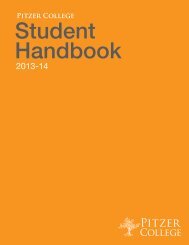

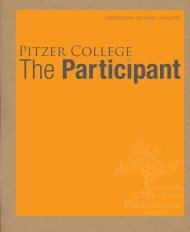
![Anticipated Courses SP14 [pdf] - Pomona College](https://img.yumpu.com/25363335/1/190x245/anticipated-courses-sp14-pdf-pomona-college.jpg?quality=85)
